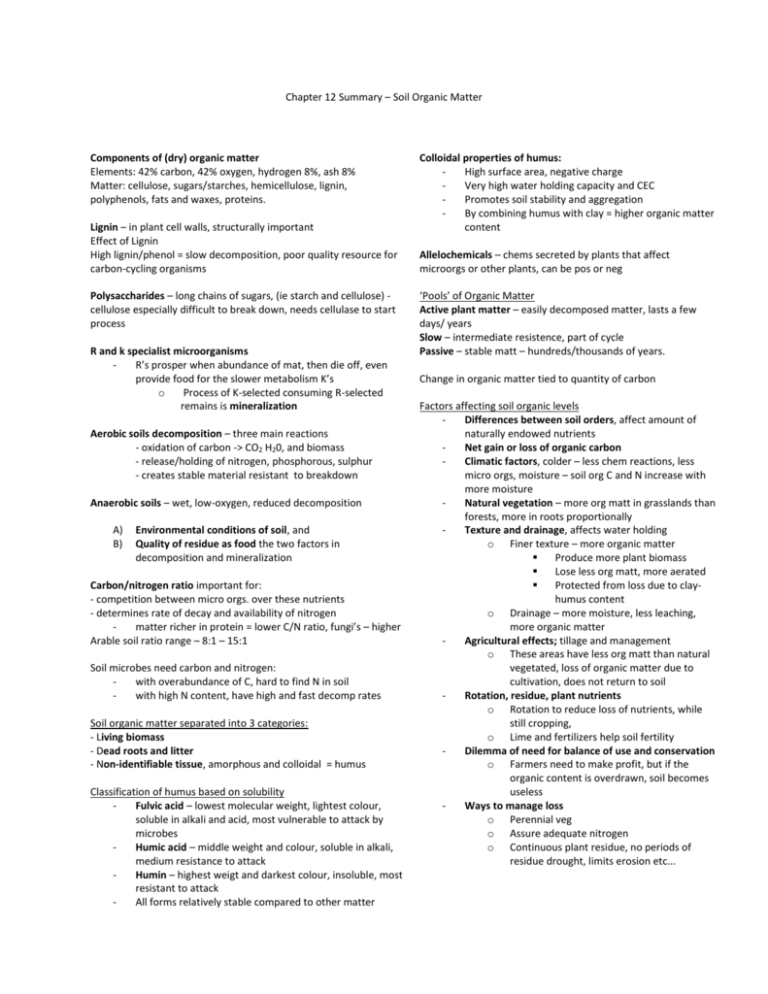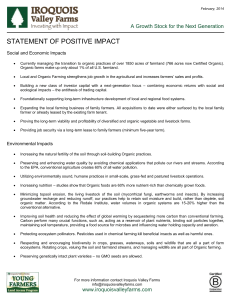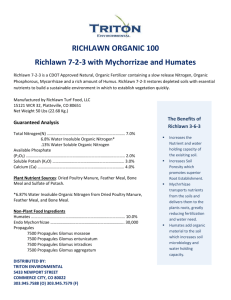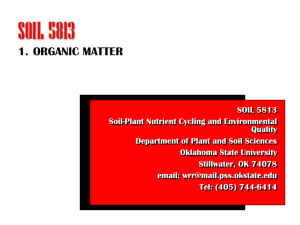geo 3080 - chp12 summary
advertisement

Chapter 12 Summary – Soil Organic Matter Components of (dry) organic matter Elements: 42% carbon, 42% oxygen, hydrogen 8%, ash 8% Matter: cellulose, sugars/starches, hemicellulose, lignin, polyphenols, fats and waxes, proteins. Lignin – in plant cell walls, structurally important Effect of Lignin High lignin/phenol = slow decomposition, poor quality resource for carbon-cycling organisms Polysaccharides – long chains of sugars, (ie starch and cellulose) cellulose especially difficult to break down, needs cellulase to start process R and k specialist microorganisms R’s prosper when abundance of mat, then die off, even provide food for the slower metabolism K’s o Process of K-selected consuming R-selected remains is mineralization Aerobic soils decomposition – three main reactions - oxidation of carbon -> CO2 H20, and biomass - release/holding of nitrogen, phosphorous, sulphur - creates stable material resistant to breakdown Anaerobic soils – wet, low-oxygen, reduced decomposition A) B) Environmental conditions of soil, and Quality of residue as food the two factors in decomposition and mineralization Carbon/nitrogen ratio important for: - competition between micro orgs. over these nutrients - determines rate of decay and availability of nitrogen matter richer in protein = lower C/N ratio, fungi’s – higher Arable soil ratio range – 8:1 – 15:1 Soil microbes need carbon and nitrogen: with overabundance of C, hard to find N in soil with high N content, have high and fast decomp rates Soil organic matter separated into 3 categories: - Living biomass - Dead roots and litter - Non-identifiable tissue, amorphous and colloidal = humus Classification of humus based on solubility Fulvic acid – lowest molecular weight, lightest colour, soluble in alkali and acid, most vulnerable to attack by microbes Humic acid – middle weight and colour, soluble in alkali, medium resistance to attack Humin – highest weigt and darkest colour, insoluble, most resistant to attack All forms relatively stable compared to other matter Colloidal properties of humus: High surface area, negative charge Very high water holding capacity and CEC Promotes soil stability and aggregation By combining humus with clay = higher organic matter content Allelochemicals – chems secreted by plants that affect microorgs or other plants, can be pos or neg ‘Pools’ of Organic Matter Active plant matter – easily decomposed matter, lasts a few days/ years Slow – intermediate resistence, part of cycle Passive – stable matt – hundreds/thousands of years. Change in organic matter tied to quantity of carbon Factors affecting soil organic levels Differences between soil orders, affect amount of naturally endowed nutrients Net gain or loss of organic carbon Climatic factors, colder – less chem reactions, less micro orgs, moisture – soil org C and N increase with more moisture Natural vegetation – more org matt in grasslands than forests, more in roots proportionally Texture and drainage, affects water holding o Finer texture – more organic matter Produce more plant biomass Lose less org matt, more aerated Protected from loss due to clayhumus content o Drainage – more moisture, less leaching, more organic matter Agricultural effects; tillage and management o These areas have less org matt than natural vegetated, loss of organic matter due to cultivation, does not return to soil Rotation, residue, plant nutrients o Rotation to reduce loss of nutrients, while still cropping, o Lime and fertilizers help soil fertility Dilemma of need for balance of use and conservation o Farmers need to make profit, but if the organic content is overdrawn, soil becomes useless Ways to manage loss o Perennial veg o Assure adequate nitrogen o Continuous plant residue, no periods of residue drought, limits erosion etc...







